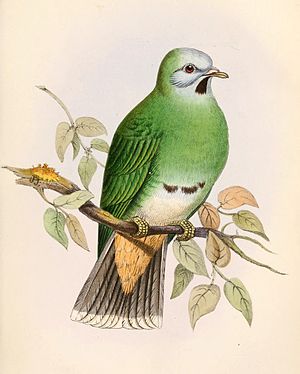Black-throated fruit pigeon
| Black-throated fruit pigeon | ||||||||||
|---|---|---|---|---|---|---|---|---|---|---|

Black-throated fruit pigeon, female |
||||||||||
| Systematics | ||||||||||
|
||||||||||
| Scientific name | ||||||||||
| Ptilinopus leclancheri | ||||||||||
| ( Bonaparte , 1855) |
The black-throated fruit pigeon ( Ptilinopus leclancheri ), also called black-chin fruit pigeon, is a medium-sized species of pigeon birds that is one of the so-called fruit pigeons . It has the high-contrast plumage typical of downy pigeons and occurs on some Philippine islands and in southern Taiwan.
In 2016, the black-throated fruit pigeon was classified in the IUCN Red List of Threatened Species as “ Least Concern (LC) ”.
Appearance
The black-throated fruit pigeon reaches a body length of 27 centimeters. This makes it a medium-sized pigeon with a comparatively long tail that is slightly smaller than a laughing pigeon . The tail accounts for between 8.5 and 9.2 centimeters. The beak is between 1.5 and 1.7 inches long. The gender dimorphism is only pronounced.
Appearance of the male
The head is silver gray, the neck and throat are greenish gray. The mantle and the small wing-coverts are bright green. The rest of the wing covers are a little lighter, the wings of the arm and the wings of the hand are a little lighter, the wings of the hand are white at the tips and the inner lugs are increasingly blackish. The wing feathers on the outer flags are lined with pale yellow. The back and the upper tail covers are bright green. The outer control feathers are slightly darker and bluer and have a gray-green end band.
The chin is black and contrasts with the ash gray throat and ear covers. The chest is a little darker gray and the same greenish-yellow monitor. It is delimited at the other end by a wide, very dark black-brown band. The belly is gray-green. The flanks are a more intense green, while the pretzel is lighter. The under tail-coverts are dark red-brown. The iris is bright red to orange-brown, the beak is bright yellow to orange-yellow with a bright red base on the lower beak. The feet are bright red.
Appearance of females and fledglings
The female has a greenish head, neck and chest. The front of the head and the reins are a bit lighter and grayish. The dark brown chest band is limited to a few dark feathers. The under tail covers are light cinnamon brown.
The young birds are similar to the females, but their chin is still pale, the chin patch is missing and the males have a dark chest band.
Possible confusion
In the distribution area of the black-throated fruit pigeon, there are two other types of downy pigeons.
The Merrill fruit pigeon is significantly larger and does not have a black chin mark. The belly is cream colored. The gray end band is missing on the control springs. The black-necked fruit pigeon is smaller and more compact. In the male, only the head is blue-gray. The chin is pale yellow, this pigeon species has a black spot on the neck.
Distribution area
The black-throated fruit pigeon has a very large distribution area and is found on a large number of Philippine islands and in southern Taiwan.
The islands of Bantayan , Banat , Biliran , Bohol, Bad, Bursa, Busuanga , Cagayancillo , Calagna-an , Calauit , Cagayan, Camigiuin Norte, Catanduanes, Cebu, Culion, Guimaras, Leyte, Luzon, Labung, Mindanao, Mindoro belong to the Philippine distribution area , Negros, Palawan, Panay, Polillo, Pujeda, Romblon, Sabtang, Samar, Semirara, Siargao, Sibuyan, Sicogon, Siquijor, Tablas and Ticao.
In addition to southern Taiwan, it also occurs on Tainan, Hsien, Hengchan and Lanyu. The black-throated fruit pigeon is very rare in Taiwan and may just be a random visitor. The pigeon is probably extinct on Cebu.
The habitat of the black-throated fruit pigeons are both primary and secondary forests in the lowlands and at altitudes of up to 700 meters.
Way of life
Black-throated fruit pigeons occasionally occur in small flocks in rich fruit-bearing trees, but they usually live solitary or in pairs. It stays almost exclusively in the treetops and picks fruit directly from the branches. It is generally a more secretive species.
It breeds from March to July. The nest is a pigeon-typical loose platform made of small branches that is erected on a horizontal branch 1.5 to 4.5 meters above the ground. The clutch consists of a single egg.
Systematics
The IUCN lists the black-throated fruit pigeon in the genus Ramphiculus, according to Avibase this assignment is not generally recognized.
attitude
The black-throated fruit pigeon was first introduced to the United States in 1965. The first breeding succeeded in California.
literature
- David Gibbs, Eustace Barnes and John Cox: Pigeons and Doves - A Guide to the Pigeons and Doves of the World . Pica Press, Sussex 2001, ISBN 90-74345-26-3 .
- Gerhard Rösler: The wild pigeons of the earth - free living, keeping and breeding . M. & H. Schaper Verlag, Alfeld-Hannover 1996, ISBN 3-7944-0184-0 .
Web links
- Ramphiculus leclancheri in the endangered Red List species the IUCN 2012. Posted by: BirdLife International, 2012. Accessed November 27, 2016th
Individual evidence
- ↑ a b Black throated fruit pigeon on Avibase , accessed on November 27, 2016
- ↑ a b c Ramphiculus leclancheri in the endangered Red List species the IUCN 2016 Posted by: BirdLife International, 2016. Retrieved on October 10, 2017th
- ^ Gibbs, Barnes and Cox: Pigeons and Doves , p. 466.
- ↑ Gibbs, Barnes and Cox: Pigeons and Doves , p. 448.
- ↑ a b Gibbs, Barnes and Cox: Pigeons and Doves , p. 467.
- ↑ Rösler: The wild pigeons of the earth , p. 271.
